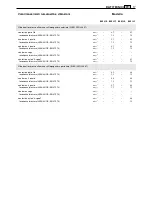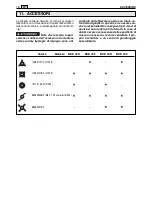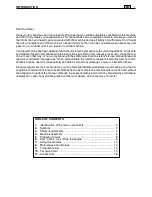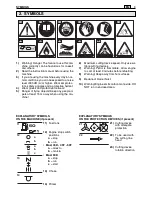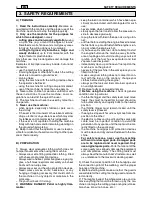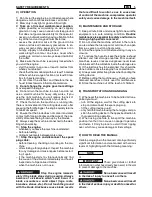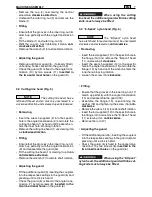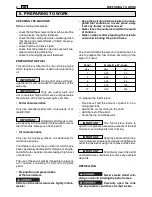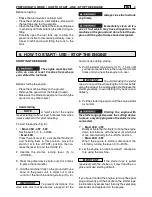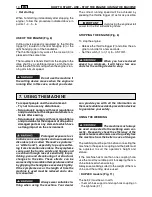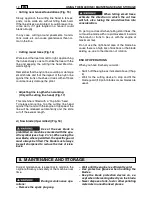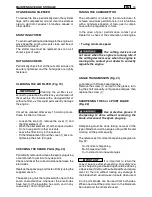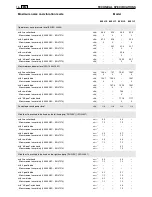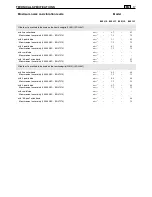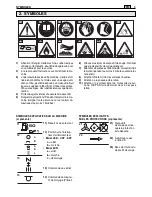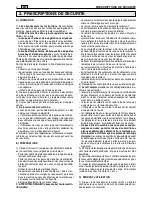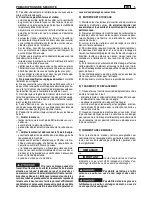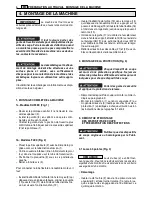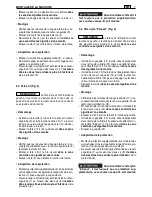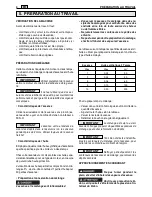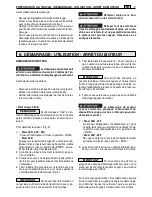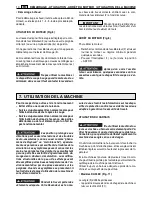
CYLINDER AND SILENCER
To reduce fire risks, periodically clean the cylinder
flaps with compressed air and clear the silencer
area to get rid of sawdust, branches, leaves or
other debris.
STARTING SYSTEM
To avoid overheating and damage to the engine, al-
ways keep the cooling air vents clean and free of
sawdust and debris.
The starter rope must be replaced as soon as it
shows signs of wear.
NUTS AND SCREWS
Periodically check that all the nuts and screws are
securely tightened and the handgrips are tightly
fastened.
CLEANING THE AIR FILTER (Fig. 19)
Cleaning the air filter is es-
sential to guarantee the efficiency and duration of
the machine. Do not work with a damaged filter or
without a filter, as this could permanently damage
the engine.
It must be cleaned after every 15 working hours.
Clean the filter as follows:
– Loosen the knob (3), remove the cover (1) and
the filter element (2).
– Wash the filter element (2) with soap and water.
Do not use petrol or other solvents.
– Leave the filter to dry in the open air.
– Fit the filter element (2) and the cover (1) back on,
tightening the knob (3) again.
CHECKING THE SPARK PLUG (Fig. 20)
Periodically remove and clean the spark plug using
a metal brush to get rid of any deposits.
Check and reset the correct distance between the
electrodes.
Replace the spark plug and fasten it firmly using the
supplied wrench.
The spark plug must be replaced with one with the
same characteristics whenever the electrodes
have burnt or the insulation has worn, and in any
case every 100 working hours.
IMPORTANT
TUNING THE CARBURETTOR
The carburettor is tuned by the manufacturer to
achieve maximum performance in all situations,
with a minimum emission of toxic gas in compli-
ance with the regulations in force.
In the case of poor performance contact your
Dealer for a check of the carburetion and engine.
•
Tuning minimum speed
The cutting device must
not move when the engine is running idle. If
the cutting device moves when the engine is
running idle, contact your dealer to correctly
regulate the engine.
ANGLE TRANSMISSION (Fig. 21)
Lubricate with lithium-based grease.
Remove the screw (1) and put in the grease, turn-
ing the shaft manually until grease emerges, then
replace the screw (1).
SHARPENING THE 3 or 4 POINT BLADE
(Fig. 22)
Use protective gloves. If
sharpening is done without removing the
blade, disconnect the spark plug cap.
Sharpening must be done taking account of the
type of blade and cutting edges, using a flat file and
working all the points equally.
The references for correct sharpening are given in
Fig. 22:
A = Incorrect sharpening
B = Sharpening limits
C = Incorrect and unequal angles
It is important to retain the
correct balance after sharpening. For safety rea-
sons, sharpening and balancing should be done by
a Specialised Centre with suitable skills and equip-
ment for the job; without risking any damage to
the blade which would make it unsafe when used.
3 or 4 point blades can be used from both sides.
When one side of the points is worn, the blade can
be turned and the other side used.
IMPORTANT
MAINTENANCE AND STORAGE
13
EN

